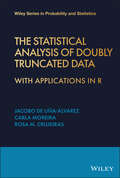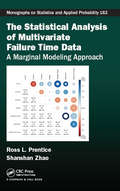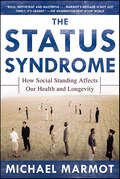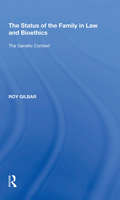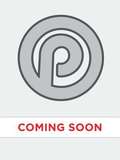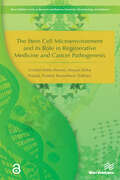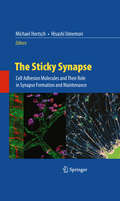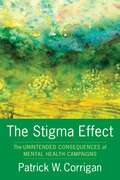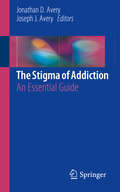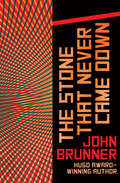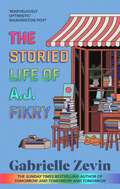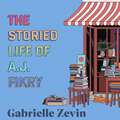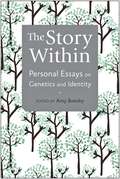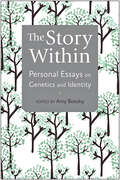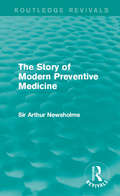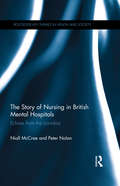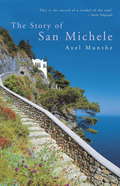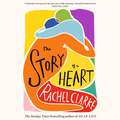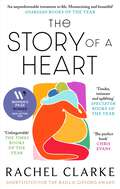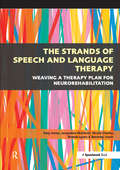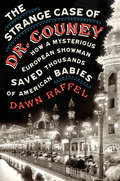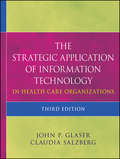- Table View
- List View
The Statistical Analysis of Doubly Truncated Data: With Applications in R (Wiley Series in Probability and Statistics)
by Rosa M. Crujeiras Jacobo de Uña-Álvarez Prof Carla MoreiraA thorough treatment of the statistical methods used to analyze doubly truncated data In The Statistical Analysis of Doubly Truncated Data, an expert team of statisticians delivers an up-to-date review of existing methods used to deal with randomly truncated data, with a focus on the challenging problem of random double truncation. The authors comprehensively introduce doubly truncated data before moving on to discussions of the latest developments in the field. The book offers readers examples with R code along with real data from astronomy, engineering, and the biomedical sciences to illustrate and highlight the methods described within. Linear regression models for doubly truncated responses are provided and the influence of the bandwidth in the performance of kernel-type estimators, as well as guidelines for the selection of the smoothing parameter, are explored. Fully nonparametric and semiparametric estimators are explored and illustrated with real data. R code for reproducing the data examples is also provided. The book also offers: A thorough introduction to the existing methods that deal with randomly truncated data Comprehensive explorations of linear regression models for doubly truncated responses Practical discussions of the influence of bandwidth in the performance of kernel-type estimators and guidelines for the selection of the smoothing parameter In-depth examinations of nonparametric and semiparametric estimators Perfect for statistical professionals with some background in mathematical statistics, biostatisticians, and mathematicians with an interest in survival analysis and epidemiology, The Statistical Analysis of Doubly Truncated Data is also an invaluable addition to the libraries of biomedical scientists and practitioners, as well as postgraduate students studying survival analysis.
The Statistical Analysis of Multivariate Failure Time Data: A Marginal Modeling Approach (Chapman & Hall/CRC Monographs on Statistics and Applied Probability #1)
by Shanshan Zhao Ross PrenticeThe Statistical Analysis of Multivariate Failure Time Data: A Marginal Modeling Approach provides an innovative look at methods for the analysis of correlated failure times. The focus is on the use of marginal single and marginal double failure hazard rate estimators for the extraction of regression information. For example, in a context of randomized trial or cohort studies, the results go beyond that obtained by analyzing each failure time outcome in a univariate fashion. The book is addressed to researchers, practitioners, and graduate students, and can be used as a reference or as a graduate course text. Much of the literature on the analysis of censored correlated failure time data uses frailty or copula models to allow for residual dependencies among failure times, given covariates. In contrast, this book provides a detailed account of recently developed methods for the simultaneous estimation of marginal single and dual outcome hazard rate regression parameters, with emphasis on multiplicative (Cox) models. Illustrations are provided of the utility of these methods using Women’s Health Initiative randomized controlled trial data of menopausal hormones and of a low-fat dietary pattern intervention. As byproducts, these methods provide flexible semiparametric estimators of pairwise bivariate survivor functions at specified covariate histories, as well as semiparametric estimators of cross ratio and concordance functions given covariates. The presentation also describes how these innovative methods may extend to handle issues of dependent censorship, missing and mismeasured covariates, and joint modeling of failure times and covariates, setting the stage for additional theoretical and applied developments. This book extends and continues the style of the classic Statistical Analysis of Failure Time Data by Kalbfleisch and Prentice. Ross L. Prentice is Professor of Biostatistics at the Fred Hutchinson Cancer Research Center and University of Washington in Seattle, Washington. He is the recipient of COPSS Presidents and Fisher awards, the AACR Epidemiology/Prevention and Team Science awards, and is a member of the National Academy of Medicine. Shanshan Zhao is a Principal Investigator at the National Institute of Environmental Health Sciences in Research Triangle Park, North Carolina.
The Status Syndrome: How Social Standing Affects Our Health and Longevity
by Michael MarmotBased on decades of his own research, a pioneering epidemiologist reveals the surprising factors behind who lives longer and whyYou probably didn't realize that when you graduated from college you increased your lifespan, or that your co-worker who has a master's degree is more likely to live a longer and healthier life. Seemingly small social differences in education, job title, income, even the size of your house or apartment have a profound impact on your health.For years we have focused merely on how advances in technology and genetics can extend our lives and cure disease. But as Sir Michael Marmot argues, we are looking at the issue backwards. Social inequalities are not a footnote to the real causes of ill health in industrialized countries; they are the cause. The psychological experience of inequality, Marmot shows, has a profound effect on our lives. And while this may be alarming, it also suggests a ray of hope. If we can understand these social inequalities, we can also mitigate their effects. In this groundbreaking book, Marmot, an internationally renowned epidemiologist, marshals evidence from around the world and from nearly thirty years of his research to demonstrate that how much control you have over your life and the opportunities you have for full social participation are crucial for health, well-being, and longevity. Just as Bowling Alone changed the way we think about community in America, The Status Syndrome will change the way we think about our society and how we live our lives.
The Status of the Family in Law and Bioethics: The Genetic Context
by Roy GilbarWhere do a doctor's responsibilities lie in communicating diagnostic and predictive genetic information to a patient's family members? On the one hand, a patient may wish to retain confidentiality while the relatives seek information; on the other, a patient may wish to share the information while the relatives would rather not know. This volume investigates the doctor's professional legal and ethical obligations in the context of these two familial tensions. The examination is conducted within the liberal-communitarian debate, whereby the two philosophies hold different perceptions of the individual and the relationship he or she has with others. Within this theoretical framework, the book examines the approach taken by English medical law and ethics to the communication of genetic information to family members. Legally, the focus is on tort law and the law of confidentiality. Ethically, it concentrates on the approach taken by the bioethical literature, and more specifically by codes of ethics and professional guidelines.
The Stem Cell Hope
by Alice ParkA landmark book by the senior science writer at Time magazine introduces us to a medical breakthrough that can save our lives. Few people know much about stem cell research beyond the ethical questions raised by using embryos. But in the last decade, stem cell research has made huge advances toward eliminating some of our most intractable diseases. Now this sweeping and accessible book introduces us to this cutting-edge science that will revolutionize medicine and change the way we think about and treat disease. Alice Park takes us from stem cell's controversial beginnings to the recent electrifying promise of being able to create the versatile cells without using embryos at all. She shows us how stem cells give researchers an unprecedented ability to study disease while giving patients the promise of replacing diseased cells with healthy new ones. And she profiles the scientists and leaders-many with their own compelling stories-who have fueled the quest and will continue to shape the field in years to come. .
The Stem Cell Microenvironment and Its Role in Regenerative Medicine and Cancer Pathogenesis
by Pranela Rameshwar Cristian Pablo Pennisi Mayuri Sinha PrasadHow stem cells behave is very much a factor of their local microenvironment, also known as the stem cell niche. Physical, chemical, or electrical signals from the neighboring cells or biochemical signals from distant cells are crucial in the cell fate decision process. A major challenge of tissue engineering is to mimic the natural cell environment by designing very sophisticated scaffolds able not only to mechanically support cells, but also to release signals biologically relevant for governing stem cell fate. In addition, increasing evidence suggests that abnormal interaction of stem cells with their niche is responsible for altered cell function leading to malignant transformation. This book discusses some of the recent advances in stem cell research that may help understanding the properties of the niche that govern stem cell fate. Technical topics discussed include:Stem cell biologyCancer stem cellsStem cell interactions with biomaterialsEngineering the stem cell microenvironmentStem cells in tissue regeneration and repairThe Disputationes Workshop series is an international initiative aimed at disseminating stem cell related cutting edge knowledge among scientists, healthcare workers, students and policy makers. This book emerges as a result of the scientific contributions presented and discussed during the fifth Disputationes Workshop held in Aalborg (Denmark) in April 2014. The stem cell microenvironment and its role in regenerative medicine and cancer pathogenesis is ideal for academic staff and master/research students in biomedical and health sciences
The Sticky Synapse
by Michael Hortsch Hisashi UmemoriThis is a comprehensive book on how adhesive proteins contribute to synapse formation, function, and remodeling. Topics covered range from general synaptic processes to CAM-specific chapters and how these CAM families contribute to synaptic functionality.
The Stigma Effect: Unintended Consequences of Mental Health Campaigns
by Patrick CorriganDespite efforts to redress the prejudice and discrimination faced by people with mental illness, a pervasive stigma remains. Many well-meant programs have attempted to counter stigma with affirming attitudes of recovery and self-determination. Yet the results of these efforts have been mixed. In The Stigma Effect, psychologist Patrick W. Corrigan examines the unintended consequences of mental health campaigns and proposes new policies in their place.Corrigan analyzes the agendas of government agencies, mental health care providers, and social service agencies that work with people with mental illness, dissecting how their best intentions can misfire. For example, a campaign to change the language around mental illness by replacing supposedly stigmatizing words with empowering ones has made little difference in how people with mental health conditions are viewed. Educational programs that frame mental illness as a brain disorder have made the general public less likely to blame people for their illnesses, but also skeptical that such conditions can be cured. Ultimately, Corrigan argues that effective strategies require leadership by those with lived experience, as their recovery stories replace ideas of incompetence and dangerousness with ones of hope and empowerment. As an experienced clinical researcher, as an advocate, and as a person who has struggled with such prejudices, Corrigan challenges readers to carefully examine anti-stigma programs and reckon with their true effects.
The Stigma of Addiction: An Essential Guide
by Jonathan D. Avery Joseph J. AveryThis book explores the stigma of addiction and discusses ways to improve negative attitudes for better health outcomes. Written by experts in the field of addiction, the text takes a reader-friendly approach to the essentials of addiction stigma across settings and demographics. The authors reveal the challenges patients face in the spaces that should be the safest, including the home, the workplace, the justice system, and even the clinical community. The text aims to deliver tools to professionals who work with individuals with substance use disorders and lay persons seeking to combat stigma and promote recovery. The Stigma of Addiction is an excellent resource for psychiatrists, addiction medicine specialists, students across specialties, researchers, public health officials, and individuals with substance use disorders and their families.
The Stone That Never Came Down
by John Brunner&“A world on the brink of war . . . Credible characters, suspenseful plotting and Brunner&’s broad vision make this humane novel a winner&” (Kirkus Reviews). The world is awash in civic decay, military coups and revolutionary governments, bands of believers ('Godheads') roaming the streets and turning plastic crosses into assault weapons. One scientist has discovered a new kind of viral drug, VC, which has the power to drastically alter the human mind. It could save civilization but at what cost? And who has the right to make a decision about whether or not to use it? Brunner at his thought-provoking, action-packed best. &“One of the most important science fiction authors. Brunner held a mirror up to reflect our foibles because he wanted to save us from ourselves.&” —SF Site
The Storied Life of A.J. Fikry
by Gabrielle ZevinThis internationally bestselling sensation is a 'funny, tender, and moving' (Library Journal, starred review) tale about community, books and second chances set in a world you won't want to leaveA.J. Fikry, the grumpy owner of Island Books, is going through a hard time: his bookshop is failing, he has lost his beloved wife, and his prized possession-a rare first edition book has been stolen. Over time, he has given up on people, and even the books in his store, instead of offering solace, are yet another reminder of a world that is changing too rapidly.But one day A.J. finds two-year-old Maya sitting on the bookshop floor, with a note attached to her asking the owner to look after her. His life - and Maya's - is changed forever.Gabrielle Zevin's enchanting novel is a love letter to the world of books--an irresistible affirmation of why we read, and why we love.Originally published as The Collected Works of A. J. Fikry.'Readers who delighted in Mary Ann Shaffer and Annie Barrows's The Guernsey Literary and Potato Peel Pie Society, Rachel Joyce's The Unlikely Pilgrimage of Harold Fry, and Jessica Brockmole's Letters from Skye will be equally captivated by this adult novel by a popular YA author about a life of books, redemption, and second chances. Funny, tender, and moving' Library Journal, starred review'This novel has humor, romance, a touch of suspense, but most of all love--love of books and bookish people and, really, all of humanity in its imperfect glory' Eowyn Ivey, author of The Snow Child
The Storied Life of A.J. Fikry
by Gabrielle ZevinBY THE AUTHOR OF THE SUNDAY TIMES BESTSELLER TOMORROW, AND TOMORROW, AND TOMORROW 'Marvelously optimistic about the future of books and bookstores and the people who love both' Washington Post A.J. Fikry, the grumpy owner of Island Books, is going through a hard time: his bookshop is failing, he has lost his beloved wife, and his prized possession - a rare first edition book has been stolen. Over time, he has given up on people, and even the books in his store, instead of offering solace, are yet another reminder of a world that is changing too rapidly. But one day A.J. finds two-year-old Maya sitting on the bookshop floor, with a note attached to her asking the owner to look after her. His life - and Maya's - is changed forever. Gabrielle Zevin's enchanting novel is a love letter to the world of books - an irresistible affirmation of why we read, and why we love. Readers say: 'A lovely uplifting book' five star reader review 'Devoured in a day. So much heart and control. Love it' five star reader review 'the writing style and characters made this novel a firm five stars' five star reader review 'This book has become my absolute favourite and not just best of the year but ever. I had to make a new shelf for it on GoodReads. I was completely blown away by it' five star reader review
The Story Within: Personal Essays on Genetics and Identity
by Amy BoeskyThe contributors to The Story Within share powerful experiences of living with genetic disorders. Their stories illustrate the complexities involved in making decisions about genetic diseases: whether to be tested, who to tell, whether to have children, and whether and how to treat children medically, if treatment is available. More broadly, they consider how genetic information shapes the ways we see ourselves, the world, and our actions within it. <P><P>People affected by genetic disease respond to such choices in varied and personal ways. These writers reflect that breadth of response, yet they share the desire to challenge a restricted sense of what "health" is or whose life has value. They write hoping to expand conversations about genetics and identity―to deepen debate and generate questions. They or their families are affected by Huntington’s disease, Alzheimer’s disease, cancer, genetic deafness or blindness, schizophrenia, cystic fibrosis, Tay-Sachs, hypertrophic cardiomyopathy, fragile X, or Fanconi anemia. All of their stories remind us that genetic health is complicated, dynamic, and above all, deeply personal.
The Story Within: Personal Essays on Genetics and Identity
by Amy BoeskyA thought-provoking collection of personal essays explores complex issues surrounding genetic identity.The contributors to The Story Within share powerful experiences of living with genetic disorders. Their stories illustrate the complexities involved in making decisions about genetic diseases: whether to be tested, who to tell, whether to have children, and whether and how to treat children medically, if treatment is available. More broadly, they consider how genetic information shapes the ways we see ourselves, the world, and our actions within it. People affected by genetic disease respond to such choices in varied and personal ways. These writers reflect that breadth of response, yet they share the desire to challenge a restricted sense of what "health" is or whose life has value. They write hoping to expand conversations about genetics and identity—to deepen debate and generate questions. They or their families are affected by Huntington’s disease, Alzheimer’s disease, cancer, genetic deafness or blindness, schizophrenia, cystic fibrosis, Tay-Sachs, hypertrophic cardiomyopathy, fragile X, or Fanconi anemia. All of their stories remind us that genetic health is complicated, dynamic, and above all, deeply personal.ContributorsMisha Angrist, Amy Boesky, Kelly Cupo, Michael Downing, Clare Dunsford, Mara Faulkner, Christine Kehl O’Hagan, Charlie Pierce, Kate Preskenis, Emily Rapp, Jennifer Rosner, Joanna Rudnick, Anabel Stenzel (deceased), Isabel Stenzel Byrnes, Laurie Strongin, Patrick Tracey, Alice Wexler
The Story Within: Personal Essays on Genetics and Identity
by Amy Boesky“A compelling collection of essays that address the experiences of many who have genetically based illnesses.” —Library JournalThe contributors to The Story Within share powerful experiences of living with genetic disorders. Their stories illustrate the complexities involved in making decisions about genetic diseases: whether to be tested, who to tell, whether to have children, and whether and how to treat children medically, if treatment is available. More broadly, they consider how genetic information shapes the ways we see ourselves, the world, and our actions within it.People affected by genetic disease respond to such choices in varied ways. These writers reflect that breadth of response, yet they share the desire to challenge a restricted sense of what “health” is or whose life has value. They write hoping to expand conversations about genetics and identity—to deepen debate and generate questions. They or their families are affected by Huntington’s disease, Alzheimer’s disease, cancer, genetic deafness or blindness, schizophrenia, cystic fibrosis, Tay-Sachs, hypertrophic cardiomyopathy, fragile X, or Fanconi anemia. All of their stories remind us that genetic health is complicated, dynamic, and above all, deeply personal.Contributors include: Misha Angrist, Amy Boesky, Kelly Cupo, Michael Downing, Clare Dunsford, Mara Faulkner, Christine Kehl O’Hagan, Charlie Pierce, Kate Preskenis, Emily Rapp, Jennifer Rosner, Joanna Rudnick, Anabel Stenzel, Isabel Stenzel Byrnes, Laurie Strongin, Patrick Tracey, Alice Wexler
The Story of Clara Barton (Cornerstones of Freedom)
by Zachary KentPresents the life and career of the nurse who, after fearlessly serving on the battlefields of the Civil War, founded the American Red Cross.
The Story of Modern Preventive Medicine: Being a Continuation of the Evolution of Preventive Medicine (Routledge Revivals)
by Sir Arthur NewsholmeFirst published in 1929, this book is a continuation of Arthur Newsholme’s Evolution of Preventive Medicine, published in 1927, which was concerned with the possibilities in progress of prevention of disease, up to the middle of the nineteenth century. The current volume focuses on the modern period and looks at the work of Louis Pasteur in particular. It provides a complete overview of the subject of preventive medicine at the time, and should be used as the basis for more detailed study. The book will be useful to those in medical circles, as well as historians interested in medicine.
The Story of Nursing in British Mental Hospitals: Echoes from the Corridors (Routledge Key Themes in Health and Society)
by Peter Nolan Niall McCraeFrom their beginnings as the asylum attendants of the 19th century, mental health nurses have come a long way. This comprehensive volume is the first book in over twenty years to explore the history of mental health nursing, and during this period the landscape has transformed as the large institutions have been replaced by services in the community. McCrae and Nolan examine how the role of mental health nursing has evolved in a social and professional context, brought to life by an abundance of anecdotal accounts. Moving from the early nineteenth to the end of the twentieth century, the book’s nine chronologically-ordered chapters follow the development from untrained attendants in the pauper lunatic asylums to the professionally-qualified nurses of the twentieth century, and, finally, consider the rundown and closure of the mental hospitals from nurses’ perspectives. Throughout, the argument is made that whilst the training, organisation and environment of mental health nursing has changed, the aim has remained essentially the same: to develop a therapeutic relationship with people in distress. McCrae and Nolan look forward as well as back, and highlight significant messages for the future of mental health care. For mental health nursing to be meaningfully directed, we must first understand the place from which this field has developed. This scholarly but accessible book is aimed at anyone with an interest in mental health or social history, and will also act as a useful resource for policy-makers, managers and mental health workers.
The Story of San Michele
by Axel MuntheThis `dream-laden and spooked? (Marina Warner, London Review of Books) story is to many one of the best-loved books of the twentieth century. Munthe spent many years working as a doctor in Southern Italy, labouring unstintingly during typhus, cholera and earthquake disasters. It was during this period that he came across the ruined Tiberian villa of San Michele, perched high above the glittering Bay of Naples on Capri. With the help of Mastro Nicola and his three sons, and with only a charcoal sketch roughly drawn on a garden wall to guide them, Munthe devoted himself to rebuilding the house and chapel. Over five long summers they toiled under a sapphire-blue sky, their mad-cap project leading them to buried skeletons and ancient coins, and to hilarious encounters with a rich cast of vividly-drawn villagers. The Story of San Michele reverberates with the mesmerising hum of a long, hot Italian summer. Peopled with unforgettable characters, it is as brilliantly enjoyable and readable today as it was upon first publication. The book quickly became an international bestseller and has now been translated into more than 30 languages; it is today an established classic, and sales number in the millions.
The Story of San Michele
by Axel MuntheThis ‘dream-laden and spooked’ (Marina Warner, London Review of Books) story is to many one of the best-loved books of the twentieth century. Munthe spent many years working as a doctor in Southern Italy, labouring unstintingly during typhus, cholera and earthquake disasters. It was during this period that he came across the ruined Tiberian villa of San Michele, perched high above the glittering Bay of Naples on Capri. With the help of Mastro Nicola and his three sons, and with only a charcoal sketch roughly drawn on a garden wall to guide them, Munthe devoted himself to rebuilding the house and chapel. Over five long summers they toiled under a sapphire-blue sky, their mad-cap project leading them to buried skeletons and ancient coins, and to hilarious encounters with a rich cast of vividly-drawn villagers. The Story of San Michele reverberates with the mesmerising hum of a long, hot Italian summer. Peopled with unforgettable characters, it is as brilliantly enjoyable and readable today as it was upon first publication. The book quickly became an international bestseller and has now been translated into more than 30 languages; it is today an established classic, and sales number in the millions.
The Story of a Heart: 'Profoundly moving and at the same time wildly inspiring' Rob Delaney
by Rachel ClarkeFROM THE AUTHOR OF THE SUNDAY TIMES BESTSELLER DEAR LIFE AND BREATHTAKING, A MAJOR TV DRAMA'Profoundly moving and at the same time wildly inspiring' Rob Delaney'The best narrative non-fiction I've read in years. Rachel Clarke has written a profound piece of investigative journalism and wrapped it up in poetry' Christie WatsonThe first of our organs to form, the last to die, the heart is both a simple pump and the symbol of all that makes us human: as long as it continues to beat, we hope. One summer day, nine-year-old Keira suffered catastrophic injuries in a car accident. Though her brain and the rest of her body began to shut down, her heart continued to beat. In an act of extraordinary generosity, Keira's parents and siblings agreed that she would have wanted to be an organ donor. Meanwhile nine-year-old Max had been hospitalised for nearly a year with a virus that was causing his young heart to fail. When Max's parents received the call they had been hoping for, they knew it came at a terrible cost to another family. This is the unforgettable story of how one family's grief transformed into a lifesaving gift. With tremendous compassion and clarity, Dr Rachel Clarke relates the urgent journey of Keira's heart and explores the history of the remarkable medical innovations that made it possible, stretching back over a century and involving the knowledge and dedication not just of surgeons but of countless physicians, immunologists, nurses and scientists.The Story of a Heart is a testament to compassion for the dying, the many ways we honour our loved ones, and the tenacity of love.
The Story of a Heart: WINNER OF THE WOMEN'S PRIZE FOR NON FICTION 2025
by Rachel ClarkeWINNER OF THE WOMEN'S PRIZE FOR NON-FICTION 2025SHORTLISTED FOR THE BAILLIE GIFFORD PRIZE FOR NON-FICTION 2024BOOK OF THE YEAR IN THE SPECTATOR, NEW STATESMAN, NEW SCIENTIST, AND PROSPECT'What a book . . . The perfect book' Chris Evans on Virgin Radio'Profoundly moving and at the same time wildly inspiring' Rob Delaney'Rachel Clarke's finest book yet' Financial Times'The best narrative non-fiction I've read in years. Rachel Clarke has written a profound piece of investigative journalism and wrapped it up in poetry' Christie Watson'This is THE MOST BEAUTIFUL and riveting book: written with such humanity, empathy and knowledge, such tact and drama and eloquence. Vital reading, lifelong revelation' Laura CummingThis is the unforgettable story of how one family's grief transformed into a lifesaving gift. With tremendous compassion and clarity, Dr Rachel Clarke relates the urgent journey of a young girl's heart and explores a history of remarkable medical innovations , stretching back over a century and involving the knowledge and dedication not just of surgeons but of countless physicians, immunologists, nurses and scientists. FROM THE AUTHOR OF THE SUNDAY TIMES BESTSELLER DEAR LIFE AND BREATHTAKING, A MAJOR TV DRAMA
The Strands of Speech and Language Therapy: Weaving Plan for Neurorehabilitation
by Katy JamesThis book is written by a team of speech and language therapists from The Wolfson Neurorehabilitation Centre. It is intended for practitioners working with patients who have acquired communication disorders resulting from brain injury: aphasia, cognitive-communication disorder, dysarthria, apraxia. The authors believe that a therapeutic programme should have it's foundations in the linguistic, non-verbal, neurological and neurospsychological perspective of the patient's difficulties. The approach the team has developed consists of several different strangs of therapy, with each strand representing an element of the rehabilitation process: assessment; goal planning; specific individualised treatment; education; friends and family; and psychosocial adjustment. This book describes these strands, illustrates in a user-friendly way how each one relates to therapy, and fives some practical ideas of how practitioners might work within them. Each chapter begins with the guiding principles and evidence bases that underlie the rationale for one particular strand of therapy. They then follow examples of practice and case studies of a real-life example of each strand. This book describes a speech and language therapy service that aims to be responsive to patients' needs and develops tailor-made intervention programmes that arer unique to each individual. It includes CD containing assessments and practical tools.
The Strange Case of Dr. Couney: How a Mysterious European Showman Saved Thousands of American Babies
by Dawn RaffelThe extraordinary tale of how a mysterious immigrant "doctor" became the revolutionary innovator of saving premature babies--by placing them in incubators in World's Fair side shows and on Coney Island and Atlantic City. What kind of doctor puts his patients on display?As Dawn Raffel artfully recounts, Dr. Couney figured out he could use incubators and careful nursing to keep previously doomed infants alive, and at the same time make good money displaying these babies alongside sword swallowers, bearded ladies, and burlesque shows. How this turn-of-the-twentieth-century émigré became the savior to families with premature infants, known then as "weaklings"--while ignoring the scorn of the medical establishment and fighting the climate of eugenics--is one of the most astounding stories of modern medicine. And as readers will find, Dr. Couney, for all his opportunistic entrepreneurial gusto, is a surprisingly appealing character, someone who genuinely cared for the well-being of his tiny patients. But he had something to hide.Drawing on historical documents, original reportage, and interviews with surviving patients, acclaimed journalist and magazine editor Dawn Raffel tells the marvelously eccentric story of Couney's mysterious carnival career, his larger-than-life personality, and his unprecedented success as the savior of tiny babies.
The Strategic Application of Information Technology in Health Care Organizations
by John P. Glaser Claudia SalzbergThis new edition of The Strategic Application of Information Technology in Health Care Organizations offers a peerless guide for health care leaders to understand information technology (IT) strategic planning and implementation. Filled with illustrative case studies, the book explores the link between overall strategy and information technology strategy. It discusses organizational capabilities, such as change management, that have an impact on an organization's overall IT effectiveness, and a wide range of IT strategy issues. The book covers emerging trends such as personalized medicine; service-oriented architecture; the ramification of changes in care delivery models, and the IT strategies necessary to support public health. "Health information technology sometimes masquerades as an end in itself. The reality is that IT is a means to an end, an enabler of the strategic goals of health care organizations. This volume reminds us that shaping IT strategy and implementation to an organization's goals is the key to generating both economic returns and safer care for patients. You don't need an engineer to understand how to use IT to advance a health care organization's strategic agenda. You just need to read this book."- Jeff Goldsmith, PhD, president of Health Futures, Inc."In this time of health care reform, nothing is more front and center than health IT. This book is an exceptional blueprint for the future, with a focus on the essential measures of success for any system implementation." - Stephanie Reel, MBA, vice provost for information technology and chief information officer, The Johns Hopkins University"In this book, the authors answer the question that every health care leader should be asking: How do we unlock the promise of health information technology and fundamentally reshape our industry? This is a must-read for every person who wants to improve American health care." - David Brailer, MD, PhD, chairman of Health Evolution Partners
